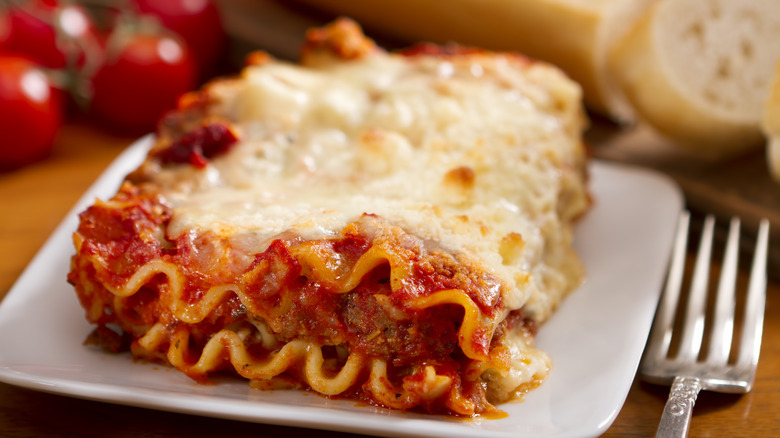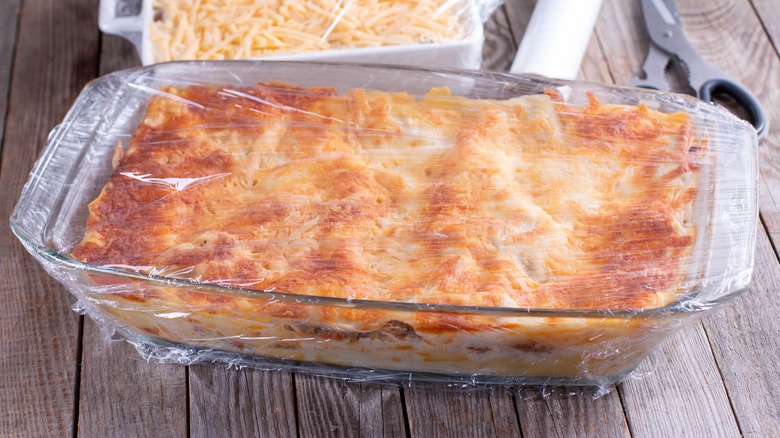Mary Berry's Noodle Tip For Better Lasagna
We may receive a commission on purchases made from links.
Lasagna is a beloved comfort food because of its layers of different textures — from the ooey gooey cheese to the crispy edges. It's also rather easy to put together, but if you want to elevate this classic dish, chef Mary Berry suggests assembling your lasagna in advance.
She shared the tip in a recipe for vegetable lasagna out of "The Complete Aga Cookbook," which she co-authored with Lucy Young. "If using dried pasta, I make this ahead in the morning or even the day before," Berry wrote. "This gives time for the sauces to soften the pasta before cooking." As the noodles rest in the sauce, they'll absorb some of the liquid from other ingredients, like marinara and béchamel sauces.
This method will work best with dried lasagna noodles, as Berry notes. The oven-ready variety is specifically designed to cook in the sauce, and these noodles will soak up the moisture. Other dried noodles — even those that suggest boiling before adding them into the dish — can even soften if they're given time to soak. Fresh, homemade noodles may be too moist on their own to properly work for this preparation method, so it's best to avoid them. But once you have your box of dried noodles ready to go, you can begin assembling your lasagna.
Timing will have an impact on the texture
The key to nailing the texture of this dish and ensuring your noodles are properly marinated is to start with tomato sauce on the bottom of the baking dish, then add your noodles on top. Then, the noodles are then topped off with a béchamel sauce and cheese, and the layers repeat. This layering method allows the noodles to be surrounded by moisture to soften up. To finish, a mozzarella-Parmesan blend can make for a crispy crust on top of the lasagna.
The length of time that you allow your assembled lasagna to rest will have an impact on the overall texture. As Berry wrote, she preps the layered dish a day or so before she plans to enjoy a slice for dinner. If you don't have that much time, the bare minimum resting period Berry recommends is 6 hours.
You should be cautious not to allow your lasagna to rest in the fridge for too long, though. Berry recommends storing the lasagna in the fridge with an airtight covering for up to 48 hours after it's fully assembled. Any longer than that, and the dish may start to take on some unpleasant textures and smells. Fortunately, if you want to make your lasagna ahead of time to enjoy later in the week, you can also opt to freeze the entire thing.
Frozen lasagna can bake up well, too
If you want to meal prep well in advance, Berry has even recommended freezing the entire lasagna prior to baking it. The lasagna can either be frozen whole, or sliced up into individual portions and packaged separately. Once frozen, the chef recommends that you enjoy your lasagna within a month — any longer may cause the texture of the dish to change.
When you're ready to heat up and eat your lasagna, you will need to take it out of the freezer and let it defrost in the fridge for a full day. After about 24 hours of defrosting, you can place your lasagna in the oven and bake it up. The dish should reach an internal temperature of 165 degrees Fahrenheit before it's sliced and served.
There are a few other time-saving tips to make your lasagna prep work even easier. Instead of mixing up a homemade marinara sauce, you can simply buy a jar from the grocery store to spoon into the dish. Alternatively, rather than using a béchamel sauce, you can simply layer on some ricotta cheese for a creamy texture. So the next time you plan to bake up a spinach and ricotta lasagna, give yourself some extra time to prep the dish a day in advance and your taste buds will thank you.



